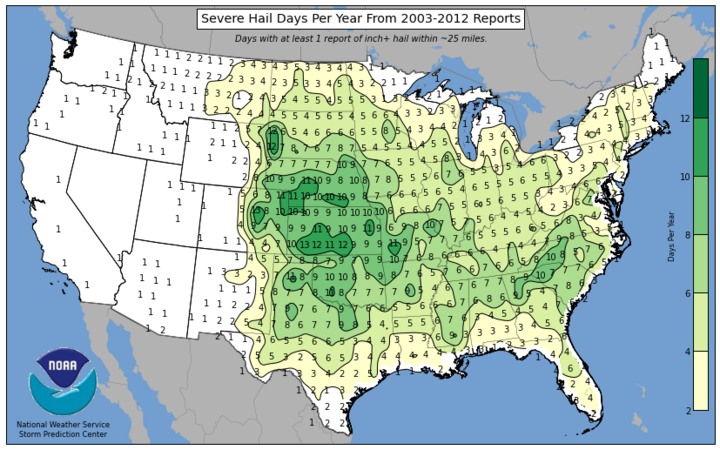Severe weather, especially hail, is commonplace during the Nebraska growing season. The impact to crops, structures, and equipment can be devastating, but planning and responding properly can save you time, money, and stress.
Know Your Risk
Nebraska and the Midwest are prone to hail events throughout the year. From 2002-2012 (Figure 1), locations in Nebraska had 7-11 hail days per year, with the highest likelihood from mid-May to mid-July. Understanding the risk of hail and the vulnerability of your operation will ultimately help you be better able to prepare and recover.
Following the weather patterns can also help you prepare for hail events. Even though you can’t stop the event, knowing the forecast and potential for development will give you time to put away equipment, alter timing of field or livestock operations, or prepare your next day for damage assessment. The Storm Prediction Center provides severe weather risk outlooks (Convective Outlooks) out to eight days. Closer to a storm, use your weather radio and local news to track storm development.

There are two ways to insure against hail. One is through your federal crop insurance contract and the other is through a hail policy. While both are insurance products, the manner in which they operate is greatly different.
- Federal crop insurance contains rules that lay out a map on your available actions, largely dependent on the severity of the hail damage and contract type.
- A hail insurance policy protects primarily against hail and therefore can help identify the risk of hail.
A hail event that damages crops is rare, making it hard to quantify risk into something useful, like expected crop damage. A much simpler way to identify your hail risk is by inspecting your hail premiums. Simply put, higher premiums equal higher risk. Hail premiums are generated from models using historical data from the region/area. While we may not know the precise calculation, we do know they use information that we likely have forgotten about. (Who wants to remember that bad hail event 20 years ago?) As a result, it is likely that we undervalue the probability of hail and therefore the expected crop damage. In reviewing hail premiums, a higher than anticipated premium should not be met with aggravation; rather, it should be met with an improved understanding of the probability of hail and the resulting financial cost along with paying the premium.
Verify Insurance Coverage
Buying a federal crop insurance or hail policy requires selecting from a menu of available contracts. Contracts insuring a larger amount imply a higher premium. If you are unsure about the contract you selected, reread the paperwork you received from your agent or just contact your agent. It is important to know your agent so you can ask them the tough questions and have someone you trust to bounce ideas off of.
After the Hail Event
If you think you have experienced damage that may result in a claim, immediately contact your agent to start the claim process. Failure to start the claim process in a timely manner may result in loss of coverage. If you are away from the location of potential storm damage, the US Storm Prediction Center provides current storm reports from any location in the U.S. If you need to refer back to an event in history, you can search for past storm at https://www.ncdc.noaa.gov/stormevents/. Be sure to review the claim process with your agent if this is your first time or if you haven’t done it in a while.
Documenting Damage
Consider photographing damage to crops, structures and equipment, noting the location (GPS if available) at the time of the event. These photos may be helpful to your insurance agent.
Most policies state that you should notify your agent within 72 hours of discovery of crop damage. Your agent will then start the claim process and an adjuster will be in touch to view the damage. The adjuster will visit the damaged field(s) and identify if a loss exists. This is where things become complicated and require a clear picture of the steps from the adjuster and/or agent. A large loss may result in the release of the field and a small loss (during the growing season) may end up not being a loss if the field grows more than expected. Once damage occurs, it’s important that you have a firm understanding of all possible choices.
For information on assessing damage see Evaluating Early-Season Hail Damage in Corn.

